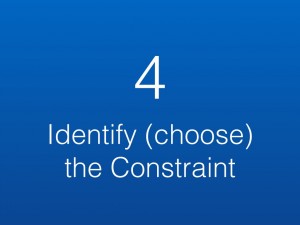Managing a network of interdependencies towards a common goal can be greatly facilitated if we choose a physical constraint, i.e. an element of the system that we elect as “leverage point” for the whole organization; normally, in a manufacturing facility such a point is a well designated machine or process phase.
From an economic, i.e. cash generation, standpoint this constraint will dictate the pace at which the whole organisational system will produce results. In other words, managing the constraint is more or less equivalent to managing the whole system.
How do we do that? By making the constraint work all the time, on the right economic mix (optimal cash generation) and by subordinating (i.e. sub-optimising) every activity of the system to the optimal functioning of the constraint.
Constraints exist!
The IM approach, instead, is to realize that constraints exist and they need to be managed. Any attempt at improvement, whether it be for individual goals or system goals, must pivot around focussing on one single point, the constraint.
It is easier to manage a constrained system because our attention does not have to be spread over all elements of the system, be they individuals and their interrelations, machines and/or activities with their interdependencies or, in the case of thinking processes, the multitude of biochemical micro reactions linked to cognition. We only have to focus on the constraint, as it is the constraint that determines the final result.
The methodology that IM uses to manage any kind of problem is the DecalogueTM.
The practical applications for managing the various kinds of constraints are different from a technical perspective, but the logical process underpinning them is always the same.
This process is made up of three phases:
- Identify
- Exploit
- Subordinate
Strategic constraint
Traditionally, the Theory of Constraints (TOC) approach explains that if you break the constraint, it will shift elsewhere and the three phases need to be repeated. The IM approach, instead, prefers to choose the constraint strategically, and design the system around that strategic constraint for as long as is possible, creating a stable system with statistical methods to manage variation, thus minimizing the disruption and cost of a constantly shifting constraint.
These three phases are completely general, and they are used both for physical constraints, such as a machine or a production phase for manufacturing, and for non-physical constraints such as those linked to organization policies, or, in general, the cognitive constraints of individuals. Examples of practical applications are Drum Buffer Rope (DBR) for production, Critical Chain for project management, and the Thinking Process Tools, a simple and yet sophisticated set of tools for thinking developed by Eliyahu Goldratt to manage non-physical constraints.





